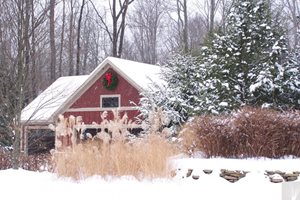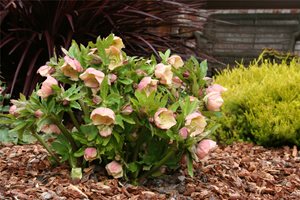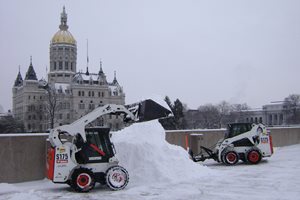Design Your Landscape for Winter
Professional tips for designing with winter conditions in mind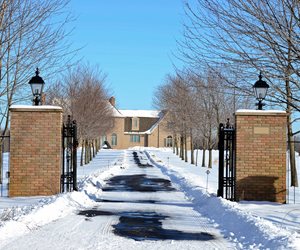
A wide driveway is easiest for a snow plow to navigate and will save you money every year on snow management.
When designing your landscape, it's easy to focus on the growing season and forget about the long winter. However, considering winter maintenance during the design phase can save you a great deal of money and energy on snow management. Good design can also allow you to use your landscaping in winter rather than just look at it from indoors.
Reducing snow management expense
"From a plowman's perspective, I see so many landscapes designed without keeping the Northeast winters in mind," says Gerry DuBreuil of Belknap Landscape Co., Inc in Gilford, NH. "If you make access difficult with a narrow driveway, electric gates, or landscaping right up to the edge of the drive, there will be a higher cost year after year for snow plowing or removal." Reduce snow management expenses with these pro tips.
- Wide driveways are best.
"The cheapest way of managing snow is with a plow truck," says DuBreuil. However, you need to leave room for the truck to get in and maneuver. - Leave a place to put the snow.
"Set the landscaping back 20 to 30 feet off the end of the drive so you have a place to put the snow," says DuBreuil. "Or, leave a 4 to 5 foot space along the side of the driveway to store snow." - Keep landscaping highly visible.
It's important to keep the landscaping back from the driveway and in highly visible locations. When everything is covered in snow, it's tough for your snow management crew to see petite plantings. - Walkways should have an even surface.
Unevenly-laid flagstone or other surfaces create a tripping hazard, and snow shovels can catch on the sharp edges and destabilize the stones. Keep up with repairs during the summer for easy winter maintenance. - Avoid lighting or gates right next to the driveway where possible.
Any light fixtures, posts, or other elements next to the driveway that could be damaged by a plow make it harder for your snow management service to get in and out quickly, which raises the expense.
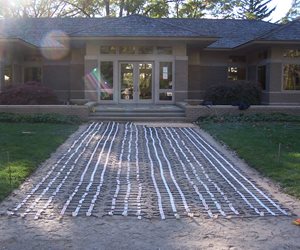
Once topped with pavers this heating system will keep the walkway warm enough to thaw snow and ice, making it safe for walking.
Using your landscape in winter
With just a little attention during the design process, you can keep your landscape usable and safe in winter. Many families use the hot tub, barbecue, or watch wildlife during winter, and you may still need to access outbuildings and sheds. Good design also increases your visual enjoyment of the winter landscape, even if you're just looking at it from your favorite chair indoors. Consider these upgrades to improve your winter view.
- Low-voltage lighting.
"In winter, when the landscape looks a little stark, it brings a whole new facet of beauty to use uplighting or downlighting on trees, statuary, or water features," says Joe Markell of Sunrise Landscape and Design in Sterling, VA. "You'd be surprised how much wildlife you can see at night with low-voltage lighting, foxes, raccoons, skunks, deer, and birds and squirrels." - Heated pathways.
"You can install a heating element on walkways which keeps them at 35 to 40°, just warm enough to keep the paths thawed and safe to walk," says Kyle Ritchie of Milieu Design LLC in Wheeling, IL. This is easiest to do when first installing the path, and is inexpensive to run once installed. - Covered structures.
If you'd like to barbecue or use the hot tub in winter, consider building a covered structure over the top of these elements to keep them free of snow. If you enjoy looking at the landscape or bird watching, a heated and insulated four-season room can give you the enjoyment of being outdoors without the frostbite. - Planting interest.
"In winter when perennials are dormant, what is there to look at in the landscape?" says Markell. "Dried ornamental grasses, evergreens with distinctive shapes, and some perennials which have large flower heads or seedpods bring interest even when covered with snow."
Dos and don'ts of material selection
When it comes to withstanding winter's temperature extremes, some materials are better suited than others. Here are some dos and don'ts for choosing materials that will hold up year-round.
- Do choose pavers for pathways.
"Pavers thaw fairly quickly, and most have contoured edges so your feet can get a good grip on them," says Markell. When installed to ICPI (Interlocking Concrete Pavement Institute) standards and sealed periodically to protect the surface, pavers are a superior choice. - Do source stone locally when possible.
Ritchie points out that sourcing stone from a region with similar weather cycles helps ensure the stone will hold up through your winter conditions. - Do use a sealant with grit on slippery stones.
If you've chosen marble or another slippery surface for your walkway, choose a sealant with grit to keep the surface walkable even when wet. - Don't use plastic edging.
"Plastic edging heaves up out of the ground," says Markell. It's not a good choice in cold climates. - Don't use cheaper wood when building a deck.
If you don't intend to use your deck in winter, then pressure-treated wood, redwood, or cedar are fine choices. However, they all absorb water, making them dangerously slippery in icy weather. Instead, Ritchie recommends tropical hardwoods such as ipe, or synthetic decking, both of which shed water easily.
- Pro Tip: "When designing your fire pit, make sure you build drainage into it," Ritchie cautions. If water sits in the fire pit and later expands with a freeze, it can break apart the structure. Plus, most people use their fire pit in late fall or spring, in between rain showers. By planning for drainage, you ensure the fire pit is ready anytime you are.

 Backyards
Backyards
 Front Yards
Front Yards
